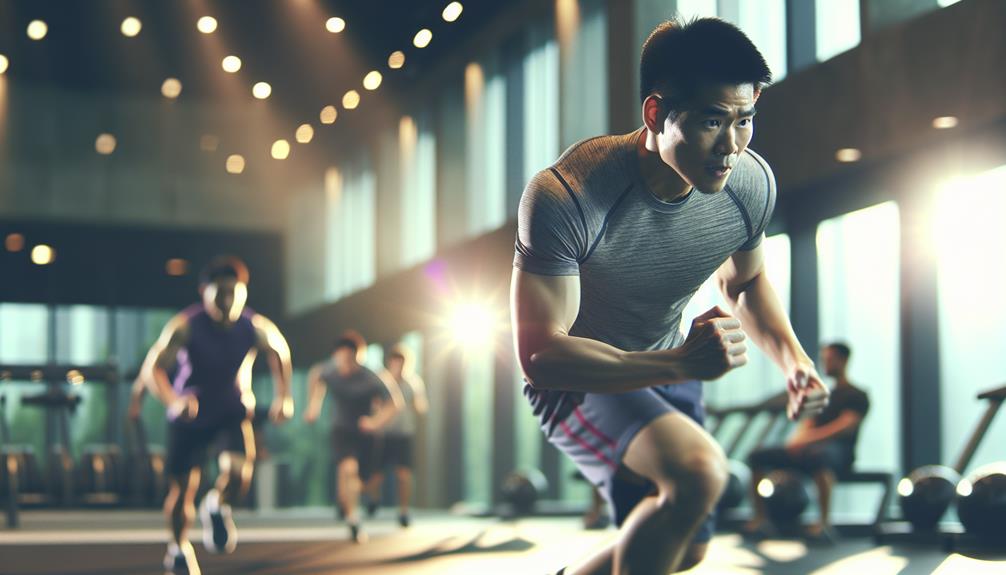Did you know that incorporating high-intensity interval training (HIIT) into your workout routine can help you maximize muscle gain? HIIT has become increasingly popular in recent years due to its efficiency and effectiveness in achieving fitness goals. But what exactly is HIIT and how can it benefit your muscle-building journey? In this discussion, we will explore the science behind HIIT, its potential advantages for muscle growth, and how you can design a HIIT routine specifically tailored to maximize your gains. Whether you're an experienced athlete or just starting your fitness journey, this information will provide valuable insights to help you take your muscle-building efforts to the next level.
Key Takeaways
- HIIT is an efficient way to burn calories and fat compared to traditional cardio.
- HIIT workouts increase metabolic rate, leading to continued calorie burn after the workout.
- HIIT combines cardiovascular exercises with strength training, improving aerobic and anaerobic fitness levels.
- HIIT stimulates muscle growth and enhances muscle fiber recruitment.
Benefits of HIIT for Muscle Gain

If you want to maximize your muscle gain, incorporating High-Intensity Interval Training (HIIT) into your routine is a highly effective approach. HIIT offers several benefits compared to traditional cardio and weightlifting. When it comes to HIIT vs. traditional cardio, HIIT has been found to be more efficient in burning calories and fat. Studies have shown that HIIT workouts can increase your metabolic rate, enabling you to continue burning calories even after your workout is over. In contrast, traditional cardio exercises like steady-state running or cycling may burn fewer calories during the workout and have a lower post-exercise calorie burn effect.
Furthermore, HIIT can also be more effective for muscle gain compared to weightlifting alone. While weightlifting primarily focuses on building strength and muscle mass, HIIT combines cardiovascular exercises with strength training. This combination helps to improve both aerobic and anaerobic fitness levels, leading to increased muscle endurance and overall muscle development. HIIT workouts involve short bursts of intense exercises, followed by brief recovery periods. This alternating pattern stimulates muscle growth and enhances muscle fiber recruitment.
Preparing for Your HIIT Workout
To effectively prepare for your HIIT workout, follow these essential steps to optimize your performance and maximize your results. One important aspect of preparation is ensuring that you have proper pre-workout nutrition. Consuming a balanced meal or snack before your HIIT session can supply your body with the necessary energy and nutrients to perform at its best. Aim for a combination of carbohydrates, protein, and healthy fats to provide sustained energy and support muscle recovery.
Another key consideration when preparing for your HIIT workout is understanding the difference between HIIT and steady-state cardio. Unlike steady-state cardio, which involves maintaining a consistent intensity for an extended period of time, HIIT alternates between high-intensity intervals and active recovery periods. This intense style of training places greater demands on your body, requiring more energy and causing a higher metabolic response. Therefore, it is crucial to properly warm up before your HIIT workout to increase blood flow to your muscles, improve flexibility, and reduce the risk of injury.
Warm-up Exercises for HIIT

When it comes to preparing for your HIIT workout, one essential aspect that should not be overlooked is incorporating warm-up exercises. These exercises help to increase blood flow, elevate your heart rate, and prepare your muscles for the high-intensity movements ahead. To effectively warm up before your HIIT session, consider incorporating the following dynamic stretching and mobility exercises:
- Jumping jacks: Start with your feet together and arms by your sides. Jump while spreading your legs and raising your arms above your head. Return to the starting position and repeat.
- High knees: Stand tall and jog on the spot while lifting your knees as high as possible. Make sure to engage your core and swing your arms for added momentum.
- Arm circles: Stand with your feet hip-width apart and extend your arms out to the sides. Make small circles with your arms, gradually increasing the size of the circles.
Dynamic stretching exercises like jumping jacks and high knees help to increase your heart rate and warm up your lower body. Meanwhile, arm circles target the upper body, improving shoulder mobility and flexibility. Incorporating these warm-up exercises into your HIIT routine can help reduce the risk of injury and improve your overall performance.
HIIT Routine for Maximum Muscle Gain
For maximum muscle gain, incorporating a high-intensity interval training (HIIT) routine into your workout regimen is crucial. HIIT is a form of exercise that alternates between short bursts of intense activity and periods of rest or low-intensity exercise. This type of training has been shown to be highly effective in building muscle and improving strength.
When it comes to building muscle with HIIT, the key is to focus on exercises that target multiple muscle groups and involve both strength and cardiovascular elements. This could include exercises such as burpees, squat jumps, and kettlebell swings. By performing these exercises in short, intense intervals, followed by brief periods of rest, you can maximize muscle activation and stimulate muscle growth.
HIIT for strength training involves pushing yourself to the limit during the intense intervals, while still maintaining proper form and technique. This intensity helps to recruit a greater number of muscle fibers, leading to increased muscle size and strength. Additionally, the short rest periods allow for quicker recovery, enabling you to perform more repetitions and increase the overall volume of your workout.
Incorporating a HIIT routine into your workout regimen can help you achieve maximum muscle gain. By targeting multiple muscle groups and pushing yourself to the limit during the intense intervals, you can stimulate muscle growth and improve strength effectively. So, if you're looking to maximize your muscle gains, give HIIT a try.
Recovery and Cool-Down After HIIT
After completing a high-intensity interval training (HIIT) routine for maximum muscle gain, it is essential to prioritize recovery and incorporate a proper cool-down. Neglecting these aspects can lead to muscle soreness, increased risk of injury, and hindered progress in your fitness journey. To ensure effective recovery and cool-down, consider implementing the following techniques:
- Active Recovery: Engage in light aerobic exercises such as walking or cycling to promote blood flow, reduce muscle stiffness, and aid in the removal of metabolic waste from your muscles.
- Foam Rolling: Use a foam roller to perform self-massage on areas of tightness or soreness. This technique helps release muscle tension, improve flexibility, and enhance recovery.
- Static Stretching: Perform static stretches targeting the muscles you worked during your HIIT routine. Hold each stretch for 15-30 seconds to improve flexibility, reduce muscle tightness, and prevent potential injuries.
Frequently Asked Questions
How Many Times a Week Should I Do HIIT Workouts for Maximum Muscle Gain?
You should do HIIT workouts 2-3 times a week for maximum muscle gain. HIIT workouts can also help with weight loss by increasing metabolism and burning calories long after your workout is done.
Can I Do HIIT Workouts if I Have a Pre-Existing Injury or Medical Condition?
Yes, you can still do HIIT workouts with a pre-existing injury or medical condition. Make sure to modify the exercises to accommodate your injury and consider alternative exercises that won't aggravate your condition.
Is It Necessary to Use Weights During a HIIT Routine for Muscle Gain?
To maximize muscle gain in a HIIT routine, using weights is not necessary. Bodyweight exercises can be equally effective. They provide resistance and engage multiple muscle groups, helping you achieve your muscle-building goals.
How Long Should Each Interval Be During a HIIT Workout for Optimal Muscle Growth?
During a HIIT workout for optimal muscle growth, the duration of each interval is important. Shorter intervals (around 20-30 seconds) with shorter rest periods (10-15 seconds) maximize muscle activation and stimulate muscle growth.
Can Beginners Incorporate HIIT Into Their Fitness Routine for Muscle Gain?
Yes, beginners can incorporate HIIT into their fitness routine for muscle gain. By making modifications for beginners, such as shorter intervals and lower intensity, they can still experience the benefits of HIIT for muscle growth.
Conclusion
In conclusion, incorporating high-intensity interval training (HIIT) into your workout routine can greatly enhance muscle gain. By combining intense bursts of exercise with short recovery periods, HIIT stimulates muscle growth and improves overall strength. Remember to properly warm up and cool down before and after each session to prevent injuries. So, why settle for ordinary workouts when you can maximize your muscle gains with the power of HIIT? Start today and see the results for yourself.











